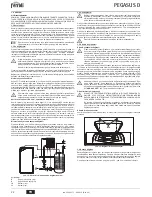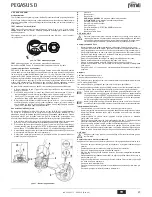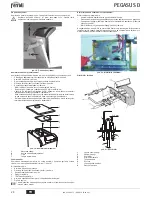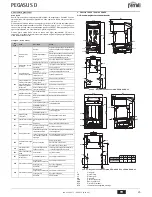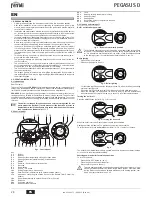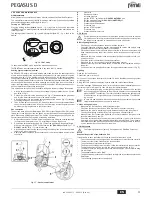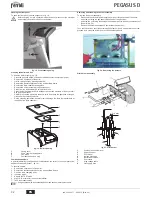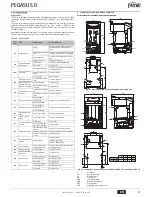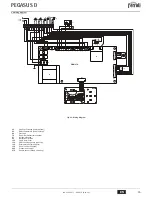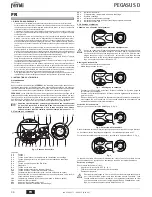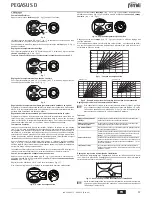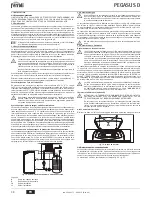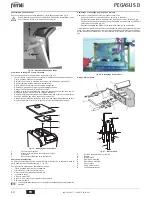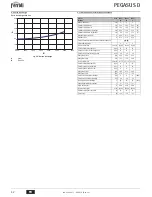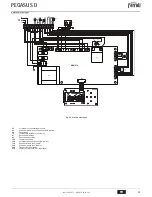
PEGASUS D
31
EN
cod. 3540U171 - 06/2012 (Rev. 00)
4. SERVICE AND MAINTENANCE
4.1 Adjustments
All adjustment and conversion operations must be carried out by Qualified Personnel.
The manufacturer declines any liability for damage and/or injury caused by unqualified
and unauthorised persons tampering with the unit.
Turning on TEST mode
Press the heating buttons
(details
3 and 4 - fig. 1) together for 5 seconds to activate
the
TEST
mode. The boiler lights at the maximum heating power set as described in the
following section.
The heating symbol (detail 24 - fig. 1) and DHW symbol (detail 12 - fig. 1) flash on the
display.
fig. 16 - TEST mode
To deactivate the
TEST
mode, repeat the activation sequence.
The
TEST
mode is automatically disabled in any case after 15 minutes.
Heating system output adjustment
On PEGASUS D boilers, the firebox heating power and therefore the heat output deliv-
ered to the heating water can only be adjusted by means of the main burner through the
gas valve, (see fig. 17). The diagrams given in the section cap. 5.2 indicate the variation
in heat output delivered to the water according to the change in burner operating pres-
sure. Being able to adjust boiler output to the actual heating requirements means above
all reducing heat losses, and therefore obtaining fuel saving. Also, with the variation in
output, also regulated by the provisions, the boilers keep their efficiency levels and com-
bustion characteristics practically unchanged
This operation is carried out with the boiler working and the water storage tank heated.
1.
Using a small screwdriver, remove the secondary operator protection cap 5 of the
gas valve of fig. 17.
2.
Connect a manometer to the pressure point 2 (fig. 17) located below the gas valve,
and turn the boiler thermostat knob to the maximum value.
3.
Adjust the pressure to the required value by means of the screw 6 (fig. 17), referring
to the diagrams given in section cap. 5.2.
4.
Then turn the burner on and off 2 or 3 times by means of the control thermostat and
check that the pressure value is that just set; otherwise, another adjustment must
be made to bring the pressure to the correct value.
Gas conversion
The unit can work with either Natural gas (G20-G25) or liquefied gas (G30-G31) and is
factory-set for use with one of the two gases, as clearly shown on the packing and data-
plate. Whenever a different gas to that for which the unit is arranged has to be used, the
special conversion kit will be required, proceeding as follows:
1.
Replace the nozzles at the main burner and pilot burner, fitting the nozzles specified
in the technical data table in cap. 5.3, according to the type of gas used
2.
Remove the small protection cap
3
(fig. 17) from the gas valve. Using a small screw-
driver, adjust the ignition “STEP” for the required gas (
G20-G25
position
D
fig. 17 or
G30-G31
position
E
fig. 17); then refit the cap.
3.
Adjust the gas pressure at the burner, setting the values given in the technical data
table for the type of gas used.
4.
Apply the sticker contained in the conversion kit, near the dataplate as proof of the
conversion.
fig. 17 - Pressure adjustment
A
Gas valve
B
Decrease pressure
C
Increase pressure
D
Ignition “STEP” adjustment for
G20-G25 NATURAL
gas
E
Ignition step adjustment for
G30-G31 LIQUEFIED
gas
1
Pressure point upstream
2
Pressure point downstream
3
Protection cap
4
Ignition STEP regulator
5
Protection cap
6
Pressure adjustment screw
4.2 Start-up
B
System start-up must be carried out by Qualified Personnel. Checks to be made at
first lighting and after all maintenance operations that involved disconnecting from
the systems or an operation on safety devices or parts of the boiler:
Before lighting the boiler
•
Open any on-off valves between the boiler and the systems.
•
Check the tightness of the gas system, proceeding with caution and using a soap
and water solution to detect any leaks in connections.
•
Fill the water system and make sure all air contained in the boiler and system has
been vented by opening the air vent valve on the boiler and any vent valves on the
system.
•
Make sure there are no water leaks in the system, domestic hot water circuits, con-
nections or boiler.
•
Check the correct connection of the electrical system.
•
Make sure the unit is connected to an efficient earthing system.
•
Make sure there are no flammable liquids or materials in the immediate vicinity of
the boiler.
•
Vent the air from the gas pipes by means of the gas valve pressure point 1 (fig. 17).
Lighting
Open the fuel on-off valves.
Connect the power to the unit.
For the next 120 seconds the display will show FH which identifies the heating system
air venting cycle.
During the first 5 seconds the display will also show the card software release.
When the message FH disappears, the boiler is ready to operate automatically whenever
domestic hot water is drawn or in case of a room thermostat demand.
A
If, after correctly carrying out the lighting procedures, the burners do not light
and the message A01 appears on the display, wait about 15 seconds and then
press the RESET pushbutton. The reset controller will repeat the lighting cycle.
If the burners do not light after several of attempts, consult the "Troubleshoot-
ing" section.
A
In case of a power failure while the boiler is working, the burners will go out and
relight automatically when the power is restored.
Checks during operation
•
Make sure the fuel circuit and water systems are tight.
•
Check the efficiency of the flue and fume ducts while the boiler is working.
•
Make sure the water is circulating properly between the boiler and the systems.
•
Check correct lighting of the boiler, by turning it on and off several times.
•
Make sure the fuel consumption indicated on the meter matches that given in the
technical data table on cap. 5.3.
•
Check the correct delivery of domestic hot water with the
'
t given in the technical
data table: do not trust measurements made with empirical systems. The measure-
ment should be made with specific instruments and as close as possible to the boil-
er, also considering the heat loss from the pipes.
4.3 Maintenance
B
The following operations must only be carried out by Qualified Personnel.
Seasonal inspection of the boiler and flue
It is advisable to have the following checks carried out at least once a year:
•
The control and safety devices (gas valve, thermostats, etc.) must function correctly.
•
The fume ducts must be clean and free of obstructions.
•
The gas and water systems must be tight.
•
The burner and exchanger must be clean. Follow the instructions in the next section.
•
The electrodes must be free of scale and properly positioned (see fig. 21).
•
The water pressure in the system when cold must be approx. 1 bar; otherwise bring
it to that value.
•
The expansion tank must be filled.
•
The gas flow and pressure must correspond to that given in the respective technical
data tables.
•
The circulating pumps must not be blocked.
eco
comfort
m
o
d
e
r e s et
bar
Summary of Contents for PEGASUS D
Page 62: ......
Page 63: ......
Page 64: ...FERROLI S p A Via Ritonda 78 a 37047 San Bonifacio Verona ITALY www ferroli it...






